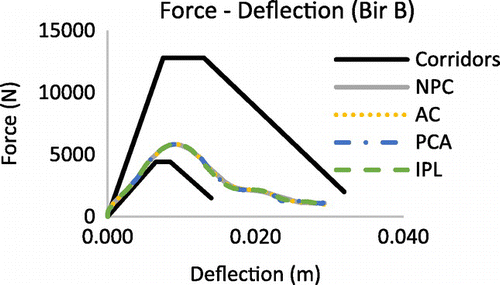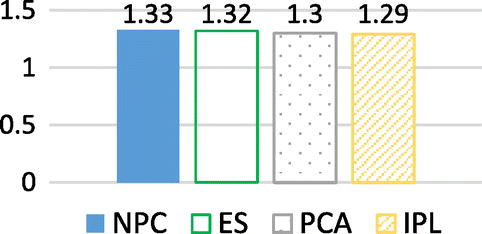1. Introduction
In a military framework, human body protection appears to be of great interest with an aim of developing and designing efficient armor for soldiers or law enforcement officers. Indeed, in the context of non-penetrating impact, the understanding of injuries caused by a ‘less lethal weapons’ is a critical point (Suyama et al. Citation2003). Focusing on the thoracic part of the human body, the influence of such loading have been widely explored, attempting to derive injury criteria from experimental tests or numerical biomechanical analysis. In the framework of less-lethal impacts, experimental tests conducted by Bir et al. (Citation2004) are considered as reference in the literature. Biomechanical corridors derived from these tests, allowing some experimental data for the validation of numerical models. Biomechanical models are considered as biofidelic, if their numerical responses in terms of impact force and sternum deflection time histories are within these corridors. In addition to these biomechanical corridors, this study of Bir et al. also provided interesting progress in thoracic less-lethal impact investigation, these kind of non-penetrating impacts often leading to lung injuries. Indeed, clinical cases related to less lethal impacts often report these kind of trauma (Wahl et al. Citation2006). Thus, for numerical replications of thoracic impacts, the way to simulate these hollow tissues is crucial in order to derive biofidelic injury criteria. Several ways are described in this paper, attempting to investigate the influence of the modelling of the lungs, and the ability to provide biofidelic numerical response, based on the replication of reference cases of the literature.
2. Methods
2.1. Various soft tissue modelling for less lethal impacts
Less lethal impacts conducted by Bir et al. (Citation2004) were replicated with a previously developed finite element model of the thorax (Roth et al. Citation2013). In order to investigate thoracic injury criteria, both bones and lungs behaviour were investigated, using different way to model soft tissue:
| • | The whole volume of the lung is considered as soft tissue, with no pulmonary cavity (NPC). | ||||
| • | Empty space is considered to represent pulmonary cavity (ES). | ||||
| • | The pulmonary cavity is filled with air (PCA). | ||||
| • | Empty space is considered to represent pulmonary cavity with initial pressure within the inner surface of the lung (IPL). | ||||
Typical global parameters were recorded in the different simulations such as force versus deflection curves as well as VCmax value defined as the maximum value of the product between the compression and the velocity of compression. Pressure being considered in the literature as an important mechanical parameter which may lead to lung injuries (Bouamoul and Williams Citation2010), this particular parameter was also investigated for the four simulations.
2.2. Mechanical constitutive model
Mechanical characterization of soft tissues is an important issue in the literature. In order to overcome the difficulties of these characterizations, some biofidelic soft tissue simulants are often used for experimental tests, as well as for numerical simulation. Ballistic gelatine being considered as an interesting substitute, constitutive law based on this biofidelic material was used for lung modelling (Taddei et al. Citation2015). The Mie-Gruneisen equation of state is used to model the pressure evolution coupled to the Johnson–Cook equation to model the strength of the material. An hydrodynamic constitutive law was used to model the air inside the lung.
3. Results and discussion
The three configurations of less-lethal impacts of Bir were simulated (cylindrical projectile impacting the sternum – Case A: 140 g at 20 m/s, case B: 140 g at 40 m/s, case C: 30 g at 60 m/s). Figure illustrates the force versus deflection curve in the sternum area, for the four different modelling of the lungs, and for one of the cases conducted by Bir et al. (case B). It can be observed the weak influence of the soft tissue modelling on the classical validations curves, the four different simulations providing biofidelic results, since all the curves were identical and also within the experimental corridors. It should be noticed that the conclusion is the same for case A and C of Bir et al. experiments.
In addition to the typical validation curves, Figure also illustrates the different values of the classical VCmax. The different numerical models provide VCmax values between 1.29 and 1.33. These values were consistent with experimental values provided by Bir et al. with VCmax ranging from 0.65 to 2.35 for case B.
More local mechanical parameters were also observed for the four soft tissue modelling, especially pressure. Table provide value of peak pressure in the lung.
Table 1. Numerical Pressure in the lung for the various models.
Among the four types of modelling, very few discrepancies exist between three cases. Only the simulation involving an empty cavity, i.e. without any numerical finite element, differed from the others. The three (NPC, PCA, IPL) configurations involve different boundary or initial conditions on the inner surface of the lung tissue. An empty space without any numerical entities (no elements) may not simulate correctly the air, and its interaction of the inner layer of the lung. This important point should be kept in mind for the modelling of hollow tissues. Non-lethal impact configurations often lead, in the literature to a tentative of correlation between global parameters such as deflection or VCmax value, and injury severity assessed by AIS scores. This injury scale is defined according to the severity of the trauma, including both skeletal or soft tissue injuries. However, the question about the relevance of describing lung tissues with global parameters such as skeletal parameter could be raised, and it seems essential to investigate local parameters (such as pressure), to explore soft tissue trauma, and to make a link between the dangerousness of a thoracic impact (AIS score) and a dedicated mechanical parameter. Then an accurate modelling of lung tissue appear essential for these kind of impacts. Further simulations are under progress in a blast framework, where pressure values were of particular interests for the evaluation of lung damage.
4. Conclusions
Non-lethal experimental impacts of the literature have been replicated with a thorax FE model, with four different types of lung modelling. These simulations led to the validation of the biomechanical model with regards to typical mechanical parameters: force, deflection, VCmax. In addition, lung pressure was also investigated providing some directions to accurately describe the lung behaviour with an aim of pulmonary trauma assessment.
Funding
This work was financially supported by the Region Franche-Comté.
References
- Bir C, Viano D, King A. 2004. Development of biomechanical response corridors of the thorax to blunt ballistic impacts. J Biomech. 37:73–79.10.1016/S0021-9290(03)00238-0
- Bouamoul A, Williams K. 2010. Effect of human and sheep lung orientation on primary blast injury induced by single blast, Personnal Armour System Symposium, (PASS 2010). Québec city, Canada; p. 149–156.
- Roth S, Torres F, Feuerstein P, Thoral-Pierre K. 2013. Anthropometric dependence of the response of a Thorax FE model under high speed loading: validation and real world accident replication. Comput Methods Programs Biomed. 110:160–170.10.1016/j.cmpb.2012.11.004
- Suyama J, Panagos PD, Sztajnkrycer MD, FitzGerald DJ, Barnes D. 2003 Aug. Injury patterns related to use of less-lethal weapons during a period of civil unrest. J Emerg Med. 25(2):219–227.10.1016/S0736-4679(03)00179-3
- Taddei L, Awoukeng Goumtcha A, Roth S. 2015. Smoothed particle hydrodynamics formulation for penetrating impacts on ballistic gelatine. Mech Res Commun. 70:94–101.10.1016/j.mechrescom.2015.09.010
- Wahl P, Schreyer N, Yersin B. 2006. Injury pattern of the flash-ball, a less-lethal weapon used for law enforcement: report of two cases and review of the literature. J Emergency Med. 31(3):325–330.10.1016/j.jemermed.2005.09.022


